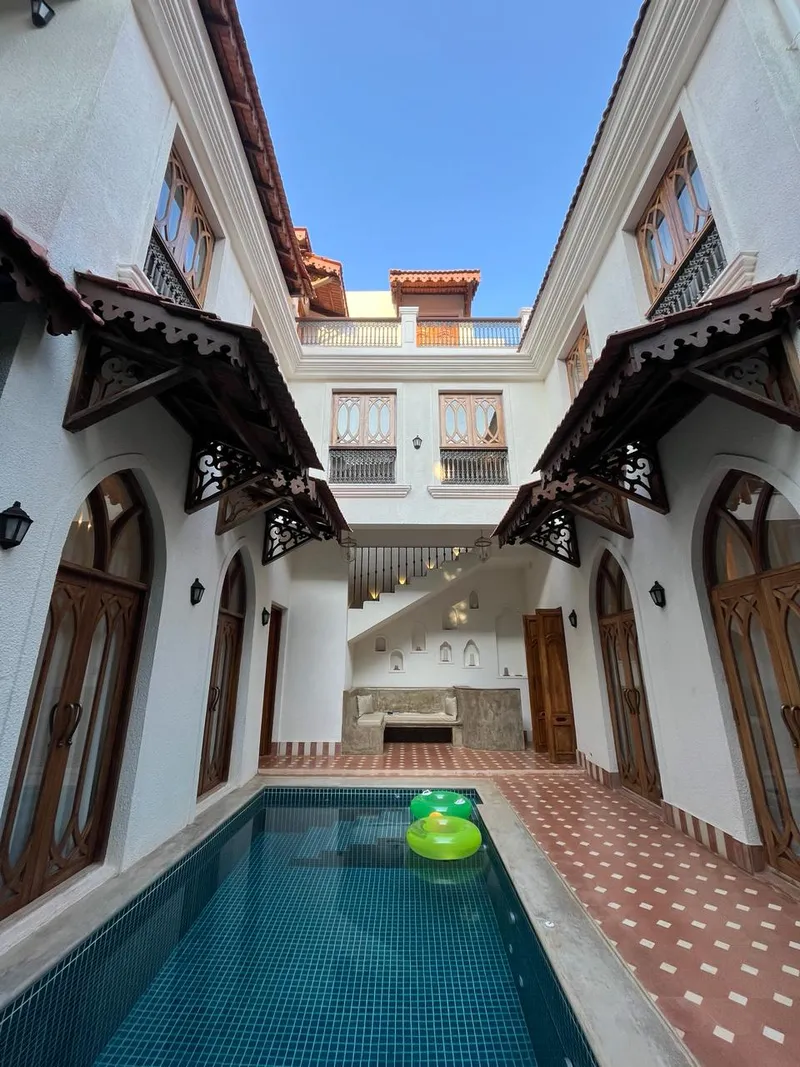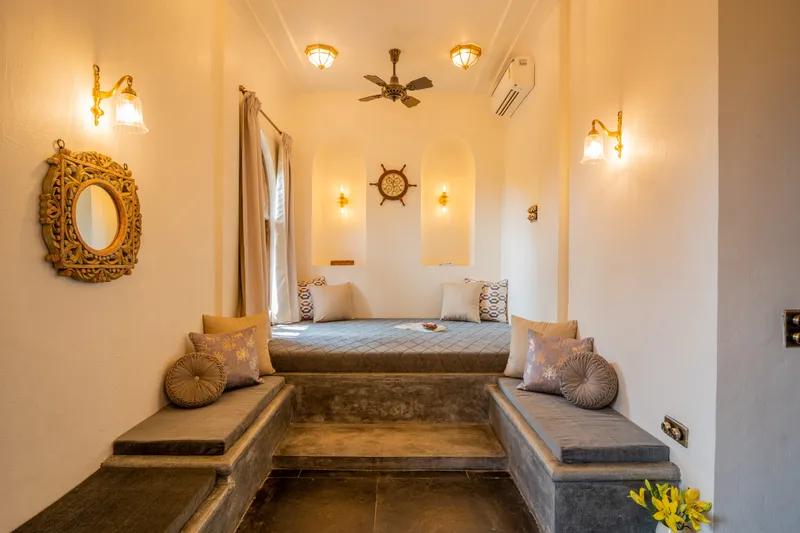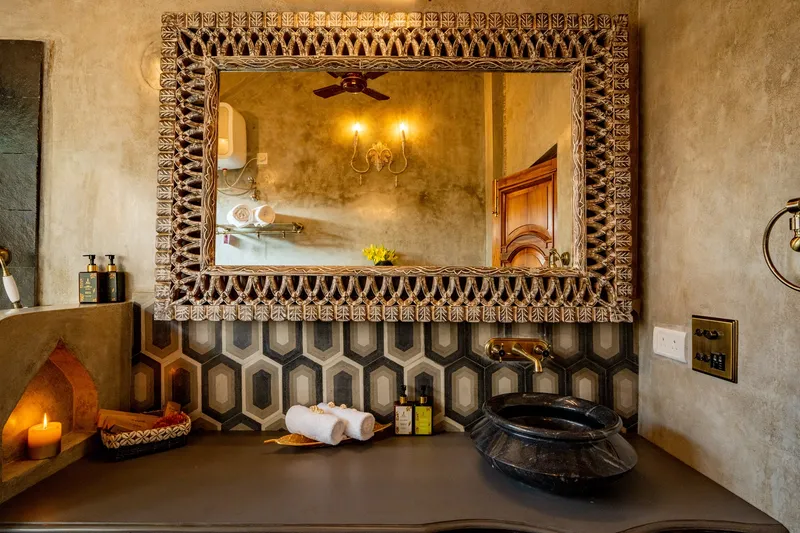A peek into Samukha, a green building certified holiday home in the heart of Goa
Developed by villa developers Aranayam, the luxury four-bedroom villa in Assagao brings together the aesthetics of Indo-Portuguese architecture and modern opulence.
A couple of years ago, one could probably not walk down the deserted lanes of Goa’s Assagao alone at night. Covered with thick green forests overshadowing the Goan-Portuguese houses, the quiet and secluded village never made it to the priority list of travellers.
But today the village has changed. And how!
Boasting beautiful restaurants offering culinary extravagance, high-end designer stores, and luxury accommodations, Assagao is today a glamourous neighbourhood attracting the creme de la creme of the tourist crowd that flocks to Goa all through the year.

The entrance has an Indo-Portuguese style balcao featuring solid teak wood columns | Image credit: Debolina Biswas
Owing to the area’s gaining popularity, Varun Maheshwari and Gaurav Khandelwal, the co-founders of villa developers Aranayam, decided to develop and launch Samukha–their first real-estate project in Assagao.
Located in one of the two arterial roads of Assagao, Samukha—a luxurious four-bedroom villa—beautifully fuses the heritage of age-old Indo-Portuguese architecture with modern opulence and amenities.
“Originating from Sanskrit, the name ‘Samukha’ represents balance, completeness and tranquillity,” Khandelwal tells YS Life.
Much like the other ten villas by Aranayam in the Sunshine State, Samukha is part of the group’s green building-certified projects—Aranayam is the first real-estate player to develop a green-certified building project in Goa.
“Every home is built to fit in seamlessly with its environs,” says Khandelwal.
He explains that the villa project was focused on using natural and sustainable materials, such as lime plaster, terrazzo flooring, and recycled teak wood.
One with nature
True to its name, as one enters through a rustic blue wooden door, they are welcomed by a traditional balcao or verandah with solid teak wood columns, which leads guests to an embellished main entrance door.
The luxury villa, built by design house Blanc Canvas and led by in-house design lead, Ishanee Ray, has been developed as two interconnected blocks, separating the living area from the dining area and entertainment room. A courtyard opens to an L-shaped pool and a built-in bar.

The villa is built as two interconnected blocks, with the courtyard opening to an L-shaped pool and built-in bar | Image credit: Debolina Biswas
The roof is built in the sundarpatti (with lace-like structures at the end) style—again inspired by the aesthetics of Goan-Portuguese architecture.
“The core of our design philosophy is an uncompromising commitment to the development’s sustainability objective. The courtyard has been designed to allow excellent airflow, which, combined with the presence of the pool water, significantly improves the surrounding microclimate,” Khandelwal elaborates.
To ensure minimum use of artificial lights and cooling agents, the villa has high ceilings and tall windows, facilitating cross ventilation throughout the day.
Without much fuss or flash—in its decor or furniture—Samukha immediately makes one feel at home.
The cosy entertainment room, featuring modern technologies, is characterised by a bed-style lounging area and is meant for movie nights with the family. Drawing inspiration from nature, the walls of the home come in earthy tones and muted shades and serve as a rustic backdrop for various antique decor elements.
Artefacts with history
The team behind Samukha has followed a similar design philosophy for the bedrooms too—inspired by Indo-Portuguese style.
The bedrooms house hardwood furniture, four-poster beds, carved ottomans, and old trunks for coffee tables, while the walls across the spaces comprise antique artefacts and earthy materials.
Khandelwal points out that many of the distinct pieces of furniture and artefacts have travelled all the way from far-off cities–“each carrying its own story and contributing to the tapestry of the villa.”

The theatre or entertainment room in Samukha features a bed-style lounding area
The living room hosts a large antique chest from Jodhpur, which has been converted into a coffee table, while the floor is adorned with natural Andhra stones, sourced locally from Goa.
The walls are adorned with rustic teak wood photo frames and wall-mounted candle stands bought from an old collectors’ shop in Delhi’s Hauz Khas Village.
In the master bedroom’s bathroom, guests can choose from an open-air bath area and a space adorned with a waterfall shower fitting. The black Kadappa stone with leather finish in the washroom not only elevates the aesthetic appeal of the space but also showcases Aranayam’s affinity towards using local materials.

The black Kadappa stone with leather finish in the washroom not only elevates the aesthetic appeal of the space but also showcases Aranayam’s affinity towards using local materials
The balcao’s roof, featuring solid teak wood columns, have been handcrafted by local Goan artisans.
“Repurposing and reusing these artefacts not only contributes to the villa’s unique character but also embodies a commitment to eco-conscious luxury,” signs off Khandelwal.
Cost per night: starts from Rs 40,000 (excluding taxes)
Edited by Swetha Kannan







